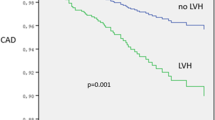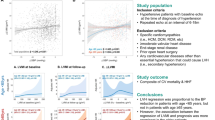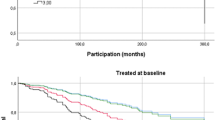Abstract
Systolic blood pressure (SBP) is an important determinant of the development and regression of left ventricular hypertrophy (LVH) in hypertensive humans. However, comparative assessments with other BP components are scarce and generally limited in size. As part of the Progetto Ipertensione Umbria Monitoraggio Ambulatoriale (PIUMA), 743 hypertensive subjects underwent echocardiography and 24-h ambulatory BP monitoring before and after an average of 3.9 years of treatment. The changes in left ventricular mass showed a significant direct association with the changes in 24-h SBP (r=0.40), diastolic blood pressure (DBP) (r=0.33) and pulse pressure (PP) (r=0.35). Weaker associations were found with the changes in clinic BP (r=0.32, 0.31 and 0.16, respectively). In a multivariate linear regression analysis, the changes in 24-h SBP were the sole independent determinants of the changes in left ventricular mass (LVM) according to the following equation: percentage changes in LVM=0.73 × (percentage changes in 24-h SBP) −0.48 (P<0.0001). For any given reduction in 24-h SBP, the reduction in LVM did not show any association with the changes in DBP and PP, either clinic or ambulatory. These data indicate that SBP is the principal determinant of LVH regression in hypertensive humans.
This is a preview of subscription content, access via your institution
Access options
Subscribe to this journal
Receive 12 digital issues and online access to articles
$119.00 per year
only $9.92 per issue
Buy this article
- Purchase on Springer Link
- Instant access to full article PDF
Prices may be subject to local taxes which are calculated during checkout



Similar content being viewed by others
References
Levy D et al. Prognostic implications of echocardiographically determined left ventricular mass in the Framingham Heart Study. N Engl J Med 1990; 322: 1561–1566.
Devereux RB, Roman MJ . Hypertensive cardiac hypertrophy: pathophysiologic and clinical characteristics. In: Laragh JH and Brenner BM (eds). Hypertension: Pathophysiology, Diagnosis and Management, 2nd edn. Raven Press, Ltd: New York, 1995, pp 409–424.
Verdecchia P et al. Circadian blood pressure changes and left ventricular hypertrophy in essential hypertension. Circulation 1990; 81: 528–536.
Nichols WW, O’Rourke MF . Atherosclerosis. In: Arnold E (ed). McDonald's Blood Flow in Arteries: Theoretical, Experimental and Clinical Principles. London, 1998, pp 396–401, Chapter 18.
Pannier B et al. Pulse pressure and echocardiographic findings in essential hypertension. J Hypertens 1989; 7: 127–132.
Baguet JP et al. Relationships between cardiovascular remodelling and the pulse pressure in never treated hypertension. J Hum Hypertens 2000; 14: 23–30.
Mourad JJ et al. Effect of hypertension on cardiac mass and radial artery wall thickness. Am J Cardiol 2000; 86: 564–567.
Verdecchia P et al. Prevalent influence of systolic over pulse pressure on left ventricular mass in essential hypertension. Eur Heart J 2002; 23: 658–665.
Mancia G et al. Ambulatory blood pressure is superior to clinic blood pressure in predicting treatment-induced regression of left ventricular hypertrophy. SAMPLE Study Group. Study on Ambulatory Monitoring of Blood Pressure and Lisinopril Evaluation. Circulation 1997; 95: 1464–1470.
Verdecchia P et al. Long-term effects of losartan and enalapril, alone or with a diuretic, on ambulatory blood pressure and cardiac performance in hypertension: a case–control study. Blood Press Monit 2000; 5: 187–193.
Verdecchia P et al. Ambulatory blood pressure: an independent predictor of prognosis in essential hypertension. Hypertension 1994; 24: 793–801.
Verdecchia P et al. Prognostic significance of serial changes in left ventricular mass in essential hypertension. Circulation 1998; 97: 48–54.
Verdecchia P et al. Quantitative assessment of day-to-day spontaneous variability in non-invasive ambulatory blood pressure measurements in essential hypertension. J Hypertens 1991; 9(Suppl 6): S322–S323.
Devereux RB et al. Echocardiographic assessment of left ventricular hypertrophy: comparison to necropsy findings. Am J Cardiol 1986; 57: 450–458.
Verdecchia P et al. Improved cardiovascular risk stratification by a simple ECG index in hypertension. Am J Hypertens 2003; 16: 646–652.
Grossman W, Jones D, McLaurin LP . Wall stress and patterns of hypertrpophy in the human left ventricle. J Clin Invest 1975; 56: 56–64.
Ganau A et al. Relation of left ventricular hemodynamic load and contractile performance to left ventricular mass in hypertension. Circulation 1990; 81: 25–36.
de Simone G, Pasanisi F, Contaldo F . Link of nonhemodynamic factors to hemodynamic determinants of left ventricular hypertrophy. Hypertension 2001; 38: 13–18.
Verdecchia P et al. Circulating insulin and insulin growth factor-1 are independent determinants of left ventricular mass and geometry in essential hypertension. Circulation 1999; 100: 1802–1807.
Verdecchia P . Prognostic value of ambulatory blood pressure. Current evidence and clinical implications. Hypertension 2000; 35: 844–851.
Gosse P et al. Regression of left ventricular hypertrophy in hypertensive patients treated with indapamide SR 1.5 mg vs enalapril 20 mg: the LIVE study. J Hypertens 2000; 18: 1465–1475.
Liebson PR et al. Comparison of five antihypertensive monotherapies and placebo for change in left ventricular mass in patients receiving nutritional–hygienic therapy in the Treatment of Mild Hypertension Study (TOMHS). Circulation 1995; 91: 698–706.
Author information
Authors and Affiliations
Corresponding author
Rights and permissions
About this article
Cite this article
Verdecchia, P., Angeli, F., Gattobigio, R. et al. Does the reduction in systolic blood pressure alone explain the regression of left ventricular hypertrophy?. J Hum Hypertens 18 (Suppl 2), S23–S28 (2004). https://doi.org/10.1038/sj.jhh.1001797
Published:
Issue Date:
DOI: https://doi.org/10.1038/sj.jhh.1001797
Keywords
This article is cited by
-
Age-dependent implications of left ventricular hypertrophy regression in patients with hypertension
Hypertension Research (2024)
-
Impact of the ambulatory blood pressure monitoring profile on cognitive and imaging findings of cerebral small-vessel disease in older adults with cognitive complaints
Journal of Human Hypertension (2022)
-
Gallic Acid Reduces Blood Pressure and Attenuates Oxidative Stress and Cardiac Hypertrophy in Spontaneously Hypertensive Rats
Scientific Reports (2017)
-
Profile of interdialytic ambulatory blood pressure in a cohort of Chinese patients
Journal of Human Hypertension (2014)
-
Diastolic blood pressure reduction contributes more to the regression of left ventricular hypertrophy: a meta-analysis of randomized controlled trials
Journal of Human Hypertension (2013)



